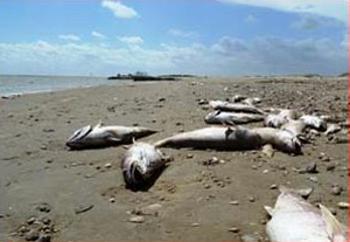GALVESTON,
Texas, August 13, 2012 (ENS) – Thousands of dead fish that washed
ashore on Galveston Island over the weekend were killed by a toxic algal
bloom, state officials confirmed Monday.
The Texas
Department of State Health Services said a bloom of Karenia brevis,
also known as red tide, was found in Galveston Bay in concentrations
high enough to kill the fish.
Texas Parks and Wildlife Department officials began receiving reports of fish kills on Friday.
The
reports were from Quintana Beach to the mouth of the Colorado River and
included mostly Gulf menhaden, also called shad, with a few mentions of
gafftopsail and hardhead catfish.
Additional
fish kills were reported over the weekend at Surfside Beach and
Galveston; samples were collected from the Surfside jetty and San Luis
Pass to look for Karenia brevis.
In
addition, fishermen reported coughing and dead fish 4 miles offshore of
Galveston. Dead flounder and stingrays have been reported at Kemah and
Bacliff.
Biologists
originally thought that low oxygen levels were to blame, so additional
investigations were conducted to determine if K. brevis was, in fact,
the cause.
On
Sunday, the Texas Health Services biologists found varying levels of K.
brevis in their sampling and officials then closed the following several
areas of Galveston Bay to shellfish harvesting.
State
officials are still investigating this event. Weather permitting, Texas
Parks and Wildlife officials intend to conduct a coastal overflight
later this week to get an aerial view of the bloom.
In
Galveston, Parks Board Executive Director Kelly de Schaun told reporters
crews worked overnight to clean the beaches most frequented by the
public and the western end of the island, which had the largest
concentrations of dead fish.
A second,
smaller wave of dead fish arrived Monday morning and was removed, she
said. Crews must clean the entire 32 miles of island beachfront, which
is likely to take until Wednesday, de Schaun said.
In 2011 a red tide covered most of the Texas Gulf Coast and Galveston Bay, closing oyster beds to harvesting.
K. brevis
produces a toxin that affects the central nervous system of fish so
that they are paralyzed and cannot breathe. As a result, red tide blooms
often result in dead fish washing up on Gulf beaches. Three common
signs of a red tide bloom are discolored water, dead fish and breathing
difficulty, according to state health officials.
Jack
Ralph, former head of the Texas Parks and Wildlife Department’s Kills
and Spills Team said it may not be necessary to cancel a trip to the
Texas Gulf coast just because of a red tide.
“If it
were my family heading to the coast, I would not cancel a vacation
because of red tide. It’s an isolated, patchy phenomenon that does not
blanket every stretch of beach. On any given day, there are generally
miles of good beach and clean water for beach-goers and anglers to
enjoy. However, we encourage all travelers to heed the advice of the
Texas Department of State Health Services, get the current facts and
draw their own conclusions, since different people have different
comfort levels with these kinds of situations.”
It’s
usually okay to eat fish, crabs and shrimp during a red tide bloom
because the toxin is not absorbed into the fleshy tissues of these
animals, says the Texas state health department which adds that people
should never eat fish found sick or dead, whether or not they are caught
during a red tide.
Sightings
of dead fish or suspected red tide can be reported 24 hours a day to
Texas Parks and Wildlife Department officials communication centers;
call 512-389-4848 in Austin or 281-842-8100 in La Porte.

No hay comentarios:
Publicar un comentario